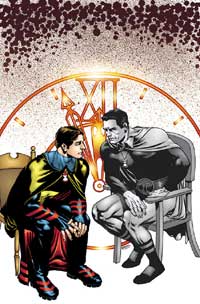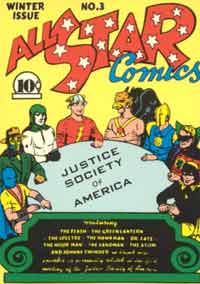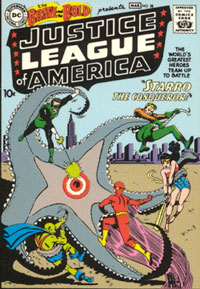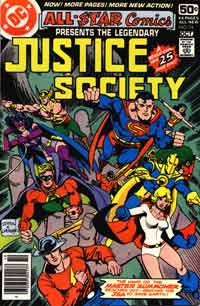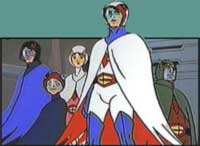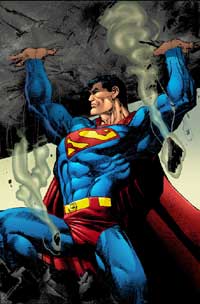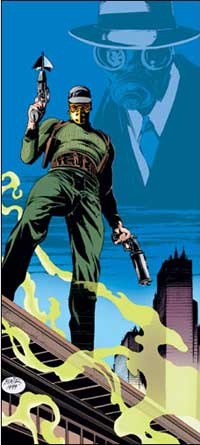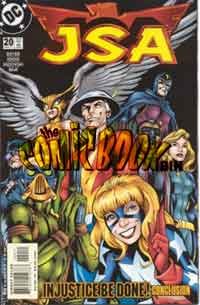Comics /
Spotlight
The Justice Society and its Archetypes
By Hervé St-Louis
April 6, 2003 - 12:04
With a large roster, the Justice Society has a great diverse cast with brilliant and different personalities. In reality, the best-selling team falls short of its ultimate potential.
This reviewer's approach to a large team of character favours casting off their personalities against each other. Therefore, characters are archetypes filling roles in.
When created, the JSA was a vehicle for the most popular characters from DC Comics' ancestors, National Periodicals and All American Comics. Bestselling characters shared the spotlight to generate more sales.
When the JSA's successors, the Justice League arrived, the same model was used. In both team, tired characters were replaced by new heroes. To this day, DC characters starring in single series often become members of the Justice League. When their series are cancelled, they often fade away.
Spin, Spin and Sell
Eventually, both teams accumulated a large cast of flamboyant and visually different characters. The difference with the JSA and the JLA is that the latter is continuously published. The JSA was first revived as guests of the JLA. From this springboard that the JSA was revived in its own series in the 1970s. It was the first since their last cancellation.
Unlike the JLA, no character had ongoing series during the 1970 series, and other JSA related titles like The All-star Squadron and the short early 1990s run. The JSA lacks a method of removing unpopular characters in favour of newer heroes actively generating money for the publisher.
Those JSA series introduced new characters, but most were legacy spinoffs. Original characters related to the JSA starred in their own series, Infinity Inc.
The current JSA run, is the only one who incorporates members who star in their own books. However, only the early run starred characters with ongoing series. Starman Jack Knight, was the star of his own critically acclaim series. Black Canary, was the co-star of the cult favourite, Birds of Prey. Hourman had his own series. The Star Spangle Kid was making her comic book debut.
IQ Versus Motivation
Unlike the JLA, JSA characters with cancelled series, were not removed. The team has continued to grow. Many of its new members are not stars of current books. In fact, the JSA has become a launch pad for from which some of its cast spins off in their own series.
There is nothing is wrong with this approach. Spinoffs can be good for the industry and a safe way to test the waters. Hawkman, reinvented within the pages of the JSA, has a new series. Developments for Captain Marvel have been rumoured. Other members of the JSA have enough appeal to warrant mini-series, one shots and regular series.
While extremely popular, the JSA has never been so much at risk of losing itself. Having become a great reservoir of legacies, spotlights for old members and a refinery for boring characters, the JSA attracts many fans and followers. Yet, the JSA characters have failed to develop any significant personality differences.
On a superficial level, everyone will agree that Jay Garrick, the Golden Age Flash, is unlike Hawkgirl. They are different characters with different motivations. Nevertheless, can anyone explain the difference between Mister Terrific, the team's resident polymorph and Dr Mid-nite, the medic with the IQ of a genius? We will try to answer this question next.
Innocence Is Bliss
Several classic animation series have traditionally used archetypes to differentiate their characters. For example, the successful Battle of the Planets cartoon has five basic archetypes. There is the alpha hero, the rebel, the young, smart Alec sidekick, the fat ridiculous social outcast and the girl. The JSA's large roster cannot emulate this simple model.
Can stories about a large team, like Justice Society, be written? So far it has. The JSA focus has been character's personalities and roller coaster adventures. The archetype model offers an alternative sound solution. Five basic archetypes exist.
The first one is the Innocent, the character who lives in a child like state. He is inexperienced, refuses to face reality and refuse to age.
The second is the Orphan. He is a disillusioned character, complaining about the unfairness of life. He has high expectations of others. His feeling of powerlessness and having fallen from grace may lead him to addictions.
We Are All Warriors
The third archetype is the Wanderer. Having lived his early life in captivity and hardships, he seeks change, continuous adventure, travel. He hates commitments and is lonely.
The next archetype is the Warrior. He is the traditional hero, whose purpose is to confront fears and challenges. Assertive, he works continuously.
The Martyr suffers hardship and self sacrifice to prevail. Unselfish he has a great unwavering sense of duty. They believe in themselves and their mission. Their work is dedicated to do the right thing, not because it benefits them, but the world or another person.
Unlike the other archetypes, the Magician lives within his environment and has no fear of it. He prefers going with the flow of the universe, instead of against it. The world is their home. They leave their guards down.
Always on the Move
Most of the characters of the JSA, like most super heroes, are nothing but Warriors. Some, like Superman and Spider-man are also Martyrs. Superman, Earth's great protector, feels the weight of the world on his shoulder. Spider-man, is characterized by the maxim "with great powers, comes great responsibility."
Let us look at some JSA characters. Sand (man) and Hourman II are virtual co-leaders of the team and Warriors. They have great leadership abilities. They are both alpha males. Besides, their personal pitfalls, failures and redemption, they have no specific purpose on the team. We don't know what drives them, besides their typical strong sense of duties.
Let's find them archetypes. Sand was held in captivity for years and transformed into a monster and caged for several decades. Before he met the Sandman and became his sidekick, he had to endure the loss of his parents. Sand is a man with a background and formative memories from the 1940s who reawakens in the present. Sand joined the JSA to become a "professional" hero and adventure seeker.
To become a perfect Wanderer, Sand would have to fear commitments, and wish to travel all over Earth to witness its marvels and catch up with the loss decades of his life. Should Sand really be the type of character to stay put, when his geo-morphing powers, allow him to travel so everywhere?
Are They All Orphans?
Hourman II is the son of the original Hourman. He came late in the lives of his parents. He was an artist whose chosen life was rejected by his father. Before taking up the mantle of the Hourman for a second time, Hourman was a crybaby and an antagonist. During his position of leadership when the entire Earth was captive of the Ultra Humanite, he became a though responsible leader.
Hourman has the qualities of a perfect Orphan, especially since if he were fatherless. Through a weird gimmick, Hourman can visit his dead father, for brief moments. Though Hourman cannot save his father, he does not seem disillusioned about the situation. Perhaps losing his father entirely or exploring the effects of having access to great artificial powers that seems to cheat life but ultimately, don't.
There are many other pairs of similar characters in the JSA. For example, Hawkgirl and the Star Spangle Kid are both teenage girls. Black Adam and Atom Smasher are big brawny men with hidden secrets. Hawkman and Wildcat are symbols for wild animals and primitive drives. Flash and Sentinel are elderly statesmen whose major difference is power-based.
Basing personalities traits on archetypes is not the only way to explore and create difference in the JSA. Yet without some quick thinking, this fabulous series cannot rely on plotting and larger than life adventures, for long.
Last Updated: March 3, 2025 - 20:40
